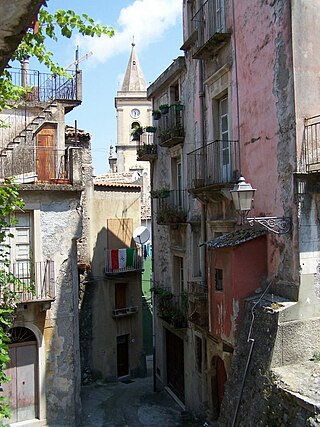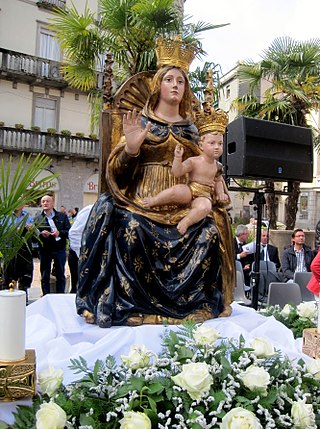
The term Black Madonna or Black Virgin tends to refer to statues or paintings in Western Christendom of the Blessed Virgin Mary and the Infant Jesus, where both figures are depicted with dark skin. Examples of the Black Madonna can be found both in Catholic and Orthodox countries.
Our Lady of Ipswich was a popular English Marian shrine before the English Reformation. Among Marian shrines, only the shrine at Walsingham attracted more visitors.

Our Lady of Mount Carmel, or Virgin of Carmel, is the title given to the Blessed Virgin Mary in her role as patroness of the Carmelite Order, particularly within the Catholic Church. The first Carmelites were Christian hermits living on Mount Carmel in the Holy Land during the late 12th and early to mid-13th century. They built in the midst of their hermitages a chapel which they dedicated to the Blessed Virgin, whom they conceived of in chivalric terms as the "Lady of the place." Our Lady of Mount Carmel was adopted in the 19th century as the patron saint of Chile.

Our Lady of Guadalupe in Extremadura is a Marian shrine in Cáceres, Spain that traces its history to the medieval kingdom of Castile. The image is enshrined in the Monastery of Santa María de Guadalupe, in the Extremadura autonomous community of Spain, and is considered the most important Marian shrine in the country.

Acquafondata is a comune (municipality) in the province of Frosinone, in the Italian region of Lazio, located in the Monti della Meta area, about 130 kilometres (81 mi) southeast of Rome and about 50 kilometres (31 mi) east of Frosinone.

Novara di Sicilia is a comune (municipality) in the Metropolitan City of Messina in the Italian region of Sicily, located about 160 kilometres (99 mi) east of Palermo and some 40 kilometres (25 mi) southwest of Messina.

Sambuca di Sicilia is a comune (municipality) in the Province of Agrigento in the Italian region Sicily, located about 68 kilometres (42 mi) southwest of Palermo and about 89 kilometres (55 mi) northwest of Agrigento. It is one of I Borghi più belli d'Italia.
The Sanctuary of Our Lady of Polsi, also known as the Sanctuary of Santa Maria di Polsi or Our Lady of the Mountain, is a Christian sanctuary in the heart of the Aspromonte mountains, near San Luca in Calabria, southern Italy. It was founded by Roger II of Sicily in 1144. The church and monastery are situated in a spectacular setting at the bottom of a gorge at an altitude of 865 metres surrounded by high mountains on the east side of the Montalto the highest peak of the Aspromonte. The sanctuary is difficult to reach. Until some years ago Polsi could only reached by foot.

The Basilica of Our Lady of Tongre is a Roman Catholic parish church and minor basilica in Tongre-Notre-Dame, Chièvres, Belgium. The shrine is small, yet rich in historical significance.

Our Lady of Europe is a title given to the Blessed Virgin Mary as patroness of Gibraltar and protectress of Europe. The entire European continent was consecrated under the protection of Our Lady of Europe in the early 14th century from the Shrine in Gibraltar where devotion continues to this day, over 700 years on.

Our Lady of Peñafrancia is an image of the Blessed Virgin Mary. A Marian image is permanently enshrined in the Minor Basilica of Our Lady of Peñafrancia in Naga, Camarines Sur.

Montisi is an Italian village in the municipality of Montalcino, Province of Siena, Tuscany. It sits on a hill on the boundary between the Val d'Orcia and the Crete Senesi.

The Basilica of Santa Maria Assunta is a 14th-century basilica in Alcamo, province of Trapani, Sicily, southern Italy. It is named after the Assumption.

The Sanctuary of Madonna dei Miracoli is a church in Alcamo, province of Trapani, Sicily, southern Italy; it is dedicated to the Madonna of the Miracles.

Our Lady of Miracles is the patron saint of the town of Alcamo.

Sant'Anna is a Catholic church in Alcamo, in the province of Trapani, Sicily, southern Italy.

The ex Church of Saint Maria del Soccorso is a Catholic Church located in Alcamo, in the province of Trapani. Sicily, Italy.

Santissimo Crocifisso is a Catholic church in Alcamo, in the province of Trapani, Sicily, southern Italy.

The Sanctuary of the Most Holy Mary of the Height is a place of Marian devotion, located on the top of Mount Bonifato, in Alcamo in the province of Trapani, Italy.

The Our Lady of Help is a statue located in Busto Arsizio. It is in the church of Santa Maria di Piazza, Busto Arsizio and it is attributed to Fabrizio De Magistris, designed in 1602, after the Madonna appeared during a plague outbreak in 1576.




















